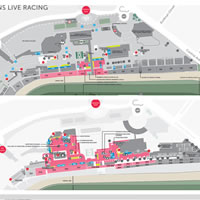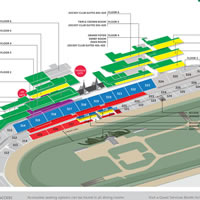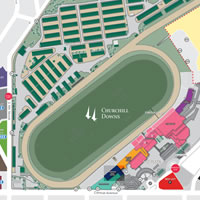History Of Churchill Downs
Lexington, Kentucky is the Thoroughbred horse capital of the world, but horse bettors are interested in the action happening an hour and a half west in Louisville. That is where the legendary Churchill Downs race course has been located since it was first opened in 1875. It was in 1872 that the initial concept of the track came about. Colonel Meriwether Lewis Clark Jr. attended the English Derby at Epsom Downs in England and was inspired to create a similar event in the United States. At the time, the two popular horse tracks in the state had been shuttered.
Clark’s uncles, John and Henry Churchill, leased 80 acres of land that was located near the Louisville and Nashville Railroad tracks. To help cover construction costs, Clark sold membership subscriptions that assisted with building a clubhouse, grandstand, Porter’s Lodge, and six stables. Churchill Downs officially opened on May 17, 1875, with three major stakes races – the Kentucky Derby, Kentucky Oaks, and Clark Handicap. Opening day at Churchill Downs amassed a crowd of 10,000 spectators.
Churchill Downs has expanded and modernized over the years. In 1893 Clark sold the track to William E. Applegate, who quickly started to make changes. The most notable was the commissioning of the twin spire grandstand, which still stands as the iconic symbol of Churchill Downs today. Architect Joseph Dominic Baldez completed the twin spires atop the grandstands in 1895. Applegate also shortened the length of the race to 1 and 1/4th miles.
The modern-day Churchill Hill Downs race track has grown significantly, spanning across 147 acres of land. The seating capacity of the venue is 52,000, while the overall capacity is around 170,000. There are also more than 77 luxury suites where spectators can watch the races. The main dirt oval (where the Kentucky Derby is run) is one mile in circumference and 79-80 feet wide, with a 120-foot wide starting gate area. Within the main track is a turf track that is 7/8 mile in circumference and 80-foot wide.
The first jockey to win the Kentucky Derby was an African-American jockey named Oliver Lewis. His colt Aristides was trained by Hall of Famer Ansel Williamson, who was also African-American. Aristides was sired by English stud Leamington through dam Sarong. Sarong was sired by Lexington, who was regarded as the leading sire in North America 16 times.
When the inaugural race was run on May 17, 1875, the length of the Kentucky Derby was 1 and ½ miles. Initially, Aristides was meant to force the pace of the other horses without winning the race. Owner Hal Price McGrath had also entered a horse named Chesapeake, who he had expected to take the lead after Aristides tired out the competition. Aristides did break out in the lead as intended, but he never slowed down and increased his speed to the point that no other horse could catch up. Aristides finished with a time of 2:37.75, two full lengths ahead of the other 14 horses in the field.
Aristides now has a life-sized statue at Churchill Downs, along with the honor of the Grade III Aristides Stakes horse race that was inaugurated in 1989.
Hundreds of thousands of horse fans come to Louisville to participate in legal Kentucky Derby betting. If you are at the track, you will first want to decide which Kentucky Derby wager type is best for your strategy. You can bet win-place-show bets, or go for exotic bets like exactas, trifectas, superfectas, or a daily double.
If you are unsure of what to say to the mutual teller, it’s quite simple. First and foremost, have your cash in hand when reaching the teller counter. Then, state the name of the track, the race number, the amount of money you are wagering, the type of bet, and the horse’s program number. An example of what you might say would be “Churchill Downs, Race 11, $2 to win on #6.”
You also have the option to use a self-service betting machine or a mobile app on your smartphone.
Churchill Downs is an exceptionally large sporting venue, with the entire facility encompassing more than 1 million square feet. Even if you have been to the track before, it can take some time to become familiar with all that the track has to offer. You can use any of the maps below, provided courtesy of Churchill Downs, to help navigate the floor, seating area, parking, and overall facility:
Directions To Churchill Downs
Churchill Downs is located on Central Ave. and is accessible from all major expressways. Whether you are coming from St. Louis, Lexington, Nashville, or Indianapolis, we can help you navigate to the storied race track. Below, you will find directions to Churchill Downs based on the city you are starting from.
From St. Louis and Points West: From I-264 East, take Exit 9 - Taylor Blvd. and turn left. Continue to head north and turn right on Central Ave. Turn right onto Kentucky Derby Drive and keep straight for Churchill Downs.
From Lexington and Points East: Starting on I-264 from I-64 W – Lexington, take Exit 10 - Third St./Southern Pkwy. Then, turn right heading north on Third St. or Southern Pkwy toward Central Ave. Turn left onto Central Ave. and make another left onto Kentucky Derby Drive. Keep straight to come into Churchill Downs.
From Nashville and Points South: From I-65 or the Nashville airport, take I-264 West to Exit 10 - Third St./Southern Pkwy. Make a right turn heading north on Third St. or Southern Pkwy toward Central Ave. and make a left. You can then turn left onto Kentucky Derby Drive to arrive at Churchill Downs.
From Indianapolis, Downtown Louisville, and Points North: Start on I-65 South and take Exit 132 to veer right on Crittenden Drive. Take the first right at the Central Ave. intersection. Continue on Central Ave. and turn left onto Kentucky Derby Dr. to enter Churchill Downs.
 Facility Map
Facility Map

